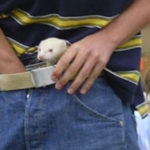 Creepy
Creepy  Creepy
Creepy  Movies and TV
Movies and TV 10 Movies That Get Elite Jobs Right, According to Experts
 Weird Stuff
Weird Stuff 10 Times Real Laws Were Based on Bizarre Hypotheticals
 Animals
Animals 10 Inspiring Tales of Horses Being Human
 Mysteries
Mysteries Top 10 Haunting Facts About the Ghost Ship MV Alta
 History
History 10 Surprising Stories About the Texas Rangers
 Humans
Humans 10 Philosophers Who Were Driven Mad by Their Own Theories
 Miscellaneous
Miscellaneous 10 Video-Game-Worthy Weapons and Armors from History
 Weird Stuff
Weird Stuff 10 Psychics Who Accurately Predicted Wartime Events
 The Arts
The Arts 10 Pieces of Art Inspired by a Broken Heart
 Creepy
Creepy 10 Death Superstitions That Will Give You the Creeps
 Movies and TV
Movies and TV 10 Movies That Get Elite Jobs Right, According to Experts
 Weird Stuff
Weird Stuff 10 Times Real Laws Were Based on Bizarre Hypotheticals
Who's Behind Listverse?

Jamie Frater
Head Editor
Jamie founded Listverse due to an insatiable desire to share fascinating, obscure, and bizarre facts. He has been a guest speaker on numerous national radio and television stations and is a five time published author.
More About Us Animals
Animals 10 Inspiring Tales of Horses Being Human
 Mysteries
Mysteries Top 10 Haunting Facts About the Ghost Ship MV Alta
 History
History 10 Surprising Stories About the Texas Rangers
 Humans
Humans 10 Philosophers Who Were Driven Mad by Their Own Theories
 Miscellaneous
Miscellaneous 10 Video-Game-Worthy Weapons and Armors from History
 Weird Stuff
Weird Stuff 10 Psychics Who Accurately Predicted Wartime Events
 The Arts
The Arts 10 Pieces of Art Inspired by a Broken Heart
10 Familiar Animals That Make Surprising Sounds
We share this planet with over a million different animal species. With so many animals to study, it’s no wonder that much of the animal kingdom remains mysterious. But sometimes, even the most common or recognizable animals can surprise us: Each species has its own way of communicating, and some of your favorite animals may sound off in a way you wouldn’t expect.
10Cheetahs Chirp Like Birds
The cheetah is the world’s fastest land animal. Once widely spread across Africa and Asia, interaction with humans has reduced Asian numbers to a few dozen. The largest concentrations are now found in Namibia, Botswana, Zimbabwe, Kenya, and Tanzania.
Unlike the other big cats (which technically belong to the genus Panthera ), cheetahs and cougars can’t roar, as they lack the necessary two-piece thyroid bone. Instead, cheetahs chirp like birds—which is, perhaps, appropriate, given their falcon-like speed. No other cat makes a similar noise.
Cheetahs also communicate heavily through purring, theoretically done through the use of a hyoid bone in the throat. Conversely, it was once thought that the roaring big cats—lions, tigers, leopards, and jaguars—were incapable of purring, since they lacked said hyoid bone. However, more recent observations suggest that the roaring cats can purr—they just can’t make any other noises at the same time, like other cats can.
9Basenji Dogs Don’t Bark—But They Yodel
(Start at around 50 seconds in the above video.)
The Basenji is a breed of dog native to Central Africa, utilized as a proficient hunter. It first left the Congo in ancient times as a gift to Egyptian pharaohs—but it didn’t make its way to England or America until the mid-1900s.
The Basenji is barkless, due to its narrow larynx. As a result, instead of barking, the Basenji vocalizes through yodels—which sound like “baroos” or howls.
Hunters likely selected the Basenji’s barkless trait deliberately; barks may have stunted a hunt by alarming rival hunters or scaring off prey.
Basenjis are known for their remarkable intelligence—as well as their tendency to be stubborn and mischievous. Inquisitive, Basenjis will likely eat anything you leave lying around, or will crawl through a fence to explore the neighborhood. Additionally, while Basenjis can certainly learn commands, they may choose to ignore them.
8Brushtail Possums Rev Like A Dying Chainsaw
Brushtail possums are marsupials, common and widespread throughout Australia (and New Zealand, after being introduced there). Opportunistic omnivores, Brushtail possums have a penchant for eating people’s gardens, but have also been known to rob birds’ nests for eggs.
When a possum is trying to intimidate or scare off a threat, it will grunt like a chainsaw, or a car running out of gas. But, like the barn owl, it may also make a horrifying screech for the same purpose.
Possum fur is extremely lightweight, yet incredibly warm—making it similar to polar bear fur, with the silk-like feel of mink. Australian natives used possum fur to make surprisingly effective warm clothes. When Europeans arrived to Australia, they saw great potential in using possums to establish a fur trade. In fact, this was the main reason they were introduced to New Zealand (where they caused a minor catastrophe to native species).
7Elephants Organize With A Growl-Like Rumble
Along with trumpeting, elephants are known to rumble. In fact, rumbling—which sounds something like a low growl—is the way they communicate most often. Rumbling is caused by a vibrating sound made in the throat.
Rumbling helps elephants organize; for example, when leaving a watering hole, elephants use rumbling to reform their hierarchical structure (females lead the herd; adult males live separately). Additionally, elephants rumble to tell other herds it’s their turn to use the watering hole. Rumbles have even been used to coordinate a herd into saving a drowning calf.
Rumbles can travel some distance, even multiple kilometers (it’s how males know when it’s time to mate). Some rumbles are so low, they can only be heard by elephants.
All species of elephant communicate via rumble. Baby elephant noises were the key component of the T. Rex’s roar in 1993’s Jurassic Park.
6Barn Owls Skip On Hooting For Shrieking
The barn owl’s blood curdling screech is far from a hoot. The barn owl—which is found on every continent except Antarctica—already looks like something from a horror movie, and its shriek completes the ensemble.
Shrieks typically last about two seconds (and are made repeatedly, though infrequently). Males scream to invite females to inspect a nest or to scare off threats; females, who scream much less often, usually do so to beg for food from their mates.
Barn owls are named for their tendency to roost in barns or old buildings. Before barns were readily available, barn owls could be found in the tree cavities of American sycamores, silver maples, and white oaks. Barn owls hatch chicks twice a year, and both parents take a role in raising their young.
Barn owl chicks may also hiss to threaten intruders—which is no less scary than the adults’ shriek.
5Guinea Pigs Sound Like A Noise Tube Toy
Do you remember the ’90s tube toy that made odd noises when flipped? (We couldn’t find an official name.)
Guinea pigs, which are actually rather vocal, communicate with a noise not dissimilar from that noise tube toy. It’s called “wheeking,” and usually conveys excitement, anticipation, or hunger. Guinea pigs also express negativity—anger, fear, or aggression—through wheeking-like noises, but these are usually accompanied by teeth chattering.
Guinea pigs originated in South America, where many used them as a source of food. Guinea pigs, which are also known as “cavies,” are rodents, and are not related to pigs at all; the name “Guinea” may derive either from Guiana (part of their natural South American range) or Guinea (an African country they were traded to). Alternatively, they may have been the cheapest source of meat (an alternative to pork) the British could have bought for one guinea—an old British denomination worth about £1.
4Elk Call Out Like Hunting Bugles
Elk—deer’s bulkier cousins—are native to North America and eastern Asia. They make their home in mountainous regions. In the US, they are mostly confined to the west, though were once found across the country. Also called wapiti (a Native American word for “light-colored deer”), elk can grow 2.7 meters (9 ft) tall, including antlers.
Breeding begins as summer ends. This is a period known as the “rut,” during which male elk compete for females. Characteristic of the rut is a passionate call, known as a “bugle”—a soaring, haunting melody, quite distinct from the horn it’s named after. The sound escalates to a loud squeal-scream, before plummeting into a series of grunts.
Elk bugling lasts from dusk to dawn, September through October. That’s plenty of time to amass a large cohort of females—and disturb every other forest animal.
3Maned Wolves Intimidate With a “Roar-Bark”
What if you combined the roar of a lion with the bark of a Rottweiler? You’d get the roar-bark of the maned wolf.
Though classified as “near threatened” by the International Union for Conservation of Nature (IUCN), the maned wolf is widely distributed throughout South America—found in Bolivia, Paraguay, Argentina, Peru, and Brazil (not to mention zoos all over the world). While it is a canid, it’s not actually a wolf at all, belonging to an entirely distinct genus (Chrysocyon). Maned wolves look something like foxes on stilts, and hunt independently.
The maned wolf’s roar-bark is impressive, but maned wolves actually mostly communicate through smell: Their urine can be detected over a kilometer (1 mi) away, and can convey a warning, sexual interest, or wolf health. Unlike many other canids, maned wolves do not howl or bay, but they do growl (when threatened) and whine (in greeting).
2Northern Mockingbirds Mimic . . . Everything
Mockingbirds love to sing—and they don’t confine themselves to one genre.
Mockingbirds are found in the New World, and are non-migratory residents of Mexico, the US, the Bahamas, the Galapagos, Cuba, and other Caribbean islands in the Antilles. Though several subspecies exist, the most widely spread is the Northern mockingbird.
Like a miniature lyre bird, the aptly-named mockingbird learns the songs of a dozen other birds (or even frogs), mimicking them for all to hear. They continue to pick up new songs their whole lives. They sing each imitation for around 20 seconds, before moving on to the next.
Both males and females sing, and they are prone to do so all day long. If you’re hearing a mockingbird sing at night, it’s more than likely a desperate male hoping to mate. If you get annoyed, though, just remember—it’s a sin to kill a mockingbird.
1The Red Fox Screams
(Start around 30 seconds in the video.)
The red fox, the largest species of fox, is one of the world’s most successful mammals; through its resourcefulness and adaptability, it’s managed to populate four continents. In fact, it has the widest distribution range of any living member of the order Carnivora (though they are actually omnivores in practice). Despite being so common, foxes are usually quite elusive.
The red fox’s bushy tail and slender appearance make it appear somewhat feline, but the red fox is actually a canid, related to dogs and wolves.
As Ylvis can attest to, foxes aren’t thought of as particularly vocal animals. While foxes do use their tails and scent to communicate, they can also emit a loud, high-pitched, scream-like bark, which is usually heard during mating season or due to conflict. Foxes also “gekker” during fights.
And now you know what the fox really says!
Josh Garcia loves animals. He has also contributed to KnowledgeNuts.







